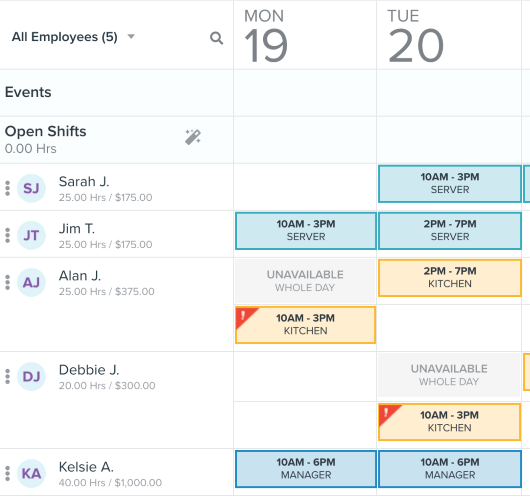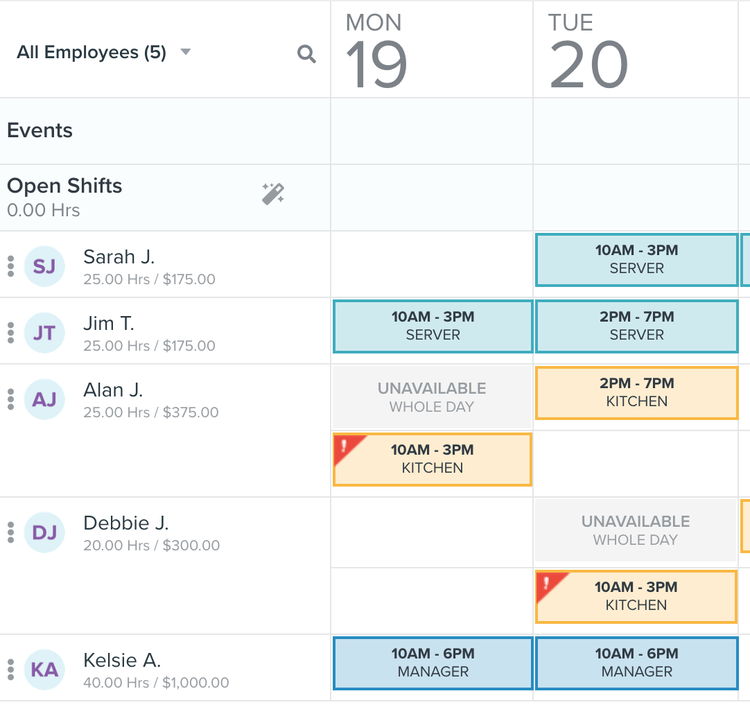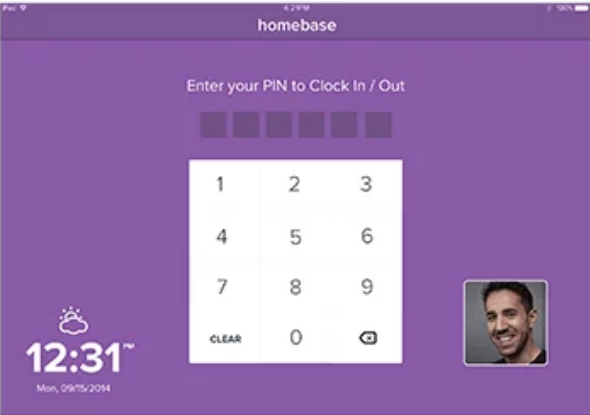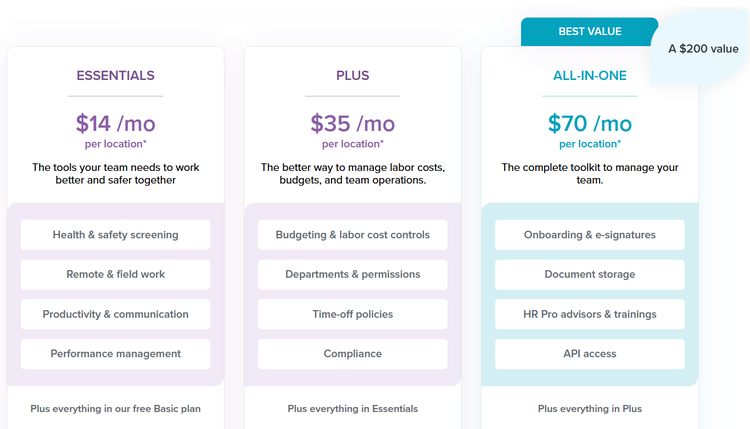Homebase is a scheduling and time clock tool that helps streamline the process of scheduling shifts for employees and keeping labor costs in check.

-
Ease Of useRating image, 5.00 out of 5 stars.5.00/5 Our ratings are based on a 5 star scale. 5 stars equals Best. 4 stars equals Excellent. 3 stars equals Good. 2 stars equals Fair. 1 star equals Poor. We want your money to work harder for you. Which is why our ratings are biased toward offers that deliver versatility while cutting out-of-pocket costs.
= Best
= Excellent
= Good
= Fair
= Poor
SupportRating image, 5.00 out of 5 stars.5.00/5 Our ratings are based on a 5 star scale. 5 stars equals Best. 4 stars equals Excellent. 3 stars equals Good. 2 stars equals Fair. 1 star equals Poor. We want your money to work harder for you. Which is why our ratings are biased toward offers that deliver versatility while cutting out-of-pocket costs.
= Best
= Excellent
= Good
= Fair
= Poor
PricingRating image, 5.00 out of 5 stars.5.00/5 Our ratings are based on a 5 star scale. 5 stars equals Best. 4 stars equals Excellent. 3 stars equals Good. 2 stars equals Fair. 1 star equals Poor. We want your money to work harder for you. Which is why our ratings are biased toward offers that deliver versatility while cutting out-of-pocket costs.
= Best
= Excellent
= Good
= Fair
= Poor
FeaturesRating image, 4.50 out of 5 stars.4.50/5 Our ratings are based on a 5 star scale. 5 stars equals Best. 4 stars equals Excellent. 3 stars equals Good. 2 stars equals Fair. 1 star equals Poor. We want your money to work harder for you. Which is why our ratings are biased toward offers that deliver versatility while cutting out-of-pocket costs.
= Best
= Excellent
= Good
= Fair
= Poor
-
- Drag-and-drop scheduling tool that makes conflicts easily identifiable
- Hiring tool included in Homebase's free basic version
- Pricing by location, not by number of employees
- Multiple role types (hourly versus salaried) not trackable unless you upgrade to a "Plus" plan
- Using a manager logbook to keep track of important shift information not available in a free plan
- Doesn't sync with employee calendars, so employees must toggle between the app and their calendars to see availability
Who is Homebase for?
Homebase is for managers who need a time clock software to schedule and keep their employees updated about shift work. Any business that schedules in shifts, such as those in the restaurant and retail industries, could use Homebase to save time creating weekly schedules.
Since Homebase charges by number of locations served and features needed, small businesses will likely find the free version the system meets most -- if not all -- of their needs.
Homebase's features
Homebase is a scheduling tool that makes scheduling shift work for employees easy. Homebase's basic version includes all the critical tools you'll need to manage and keep track of employee hours, including the ability to clock in and out, view timesheets, and allow communication between managers and employees.
Its paid plans include access to more advanced features, such as geofencing and manager log books for businesses looking for more ways to save time and money when scheduling.
Scheduling
Homebase offers an easy-to-use drag-and-drop scheduling tool. To streamline scheduling, you can save commonly worked shifts or whole scheduling templates so you don't have to start from scratch every week.

See employee schedules at a glance in Homebase. Source: Homebase software.
Employees can log their availability, and managers can add notes so they remember requested days off or preferred shifts that typically work well for employees' schedules. If you accidentally schedule someone on a day off, conflicts get flagged in your schedule builder so you can immediately identify and correct them.

Seen when your schedule includes conflicts in Homebase. Image source: Author
Employees can also request time off through Homebase, and you can allow employees to pick up open shifts and approve any shift trade requests your employees might have.
Accountability
Download Homebase's app on a tablet, prompt employees to download the app on their phones, or enable employees to clock in via a desktop or workstation with Homebase's web app. You can allow employees to clock in based on their geolocation or with a PIN.
And although Homebase doesn't offer facial recognition, you can set up the time clock to take a picture of your employee as they clock in to prevent buddy punching.

Clock in with a PIN via a tablet. Image source: Author
Using Homebase's timesheet reports, you can view all of your employees' timesheets in one place. Errors and no-shows are color coded to make absences easily identifiable.

Easily identify attendance issues with Homebase's timesheet reports. Image source: Author
Budgeting
Homebase integrates with multiple popular payroll solutions, like Gusto, Square, and QuickBooks, to ensure that employees are paid for all their hours worked. However, you don't have to wait until payday to see how much you're spending on labor costs.
As you make each schedule, you'll see a summary report of how many hours you've scheduled and what you can expect to pay employees. And using Homebase's timesheet report, you can see how much you can expect to spend on wages and how your profit margins are doing when you compare your labor costs to sales.

Approve and track time off requests in Homebase. Image source: Author
To track sales numbers more effectively, Homebase integrates with multiple popular point of sale (POS) systems, such as Clover, Square, and Toast.
Teamwork and collaboration
Using Homebase's mobile app, employees can access their schedules from their phones. Managers can also send group messages to their whole staff or to relevant team members so everyone is on the same page. And if you've upgraded to a "Plus" account, you can also access Homebase's manager log from the mobile app to see relevant information about shifts and teams even if you're not in the office.
Benefits of using Homebase
Homebase aims to be a one-stop shop for managing your staff. With its intuitive scheduling tools, integrations with popular payroll and POS tools, and even a hiring tool, you'll be able to monitor shift coverage, keep labor costs down, and put out the call for new team members when you're short-staffed (or when it's time to expand) all from one system.
Since Homebase charges by location and features (more on that below) and not by number of employees, you won't have to worry about growing out of one of its more basic solutions before you're ready to foot the bill. Plus, Homebase really tries to help you stay on top of labor compliance law trends.
For example, even their basic free plan offers unlimited scheduling so you can create predictive schedules -- even if your state doesn't mandate them yet. By making it easy to follow the rules, Homebase is a scheduling tool both you and your employees will love to use.
Homebase pricing
Homebase charges by location and the features your business needs to access. They also offer a free tier, which, even though it's "basic," has quite a lot to offer for a free option, including:
- Unlimited employees
- Unlimited advance scheduling
- Hiring tools
- Access to mobile apps
- Several different time clock options

Homebase offers several pricing tiers based on locations served and features offered. Image source: Author
Especially for small businesses and startups, this feature-rich "Basic" solution could easily meet your scheduling needs for quite some time. And if you find yourself needing access to more advanced features, the next tier of Homebase only costs $14 per location, per month (with an annual plan, that is -- all plans are 30% more expensive if you opt for month-to-month).
That means that even if you've expanded to 1,000 employees (wow, good for you!) but are still operating out of a single location, Homebase will cost just a few dollars per month.
Given the lack of limits and its robust functionality for even its most basic package -- which still costs nothing -- Homebase is definitely one of the best deals for scheduling tools on the market.
Ease of use
In addition to creating a schedule, you can complete most critical managerial functions, such as tracking hours worked and avoiding conflicts, from Homebase's scheduling tool. The ability to do pretty much anything from one screen makes Homebase easy to navigate. Even for functions that weren't located in the scheduling tool, I never found myself searching through different menus or wondering where anything was.
Getting started
From the scheduling tool, you can add employees, create roles, define wages, and add shifts to Homebase. Especially for new users, being able to set your company up from one place helps you quickly get oriented with how Homebase works. From the settings tool, you can customize stipulations and rules concerning things like notifications, overtime, and breaks.
After you've configured Homebase to meet the needs of your business, you just need to decide how your employees will clock in (via a web, mobile, or tablet app), and your employees can start tracking hours.
How Homebase Compares
| Schedule Building | Clocking in and out | Availability and time off management | Payroll integration or exporting | |
|---|---|---|---|---|
| Homebase |
|
|
|
|
| Replicon |
|
|
|
|
| When I Work |
|
|
|
|
| ClockShark |
|
|
|
|
| TimeCamp |
|
|
FAQs
-
If you expand beyond one location, you'll have to start paying $16 per location, per month, at a minimum. Or if you discover you need or want access to more advanced tools, such as a mobile time clock, time off accrual tracking, or auto scheduling, you'll have to shell out for one of Homebase's paid plans.
-
Any industry that needs to schedule shift work could use Homebase. So restaurants and retail outlets are definitely some of Homebase's top target customers. However, Homebase also mentions that it caters to bars, food trucks, and businesses in the service industry, along with quite a few other types of businesses.
-
Since unlimited scheduling is included in all Homebase plans, you can offer predictive scheduling (required in some states) to your staff even if you're only on the free plan. However, when it comes to staying in compliance with PTO laws, you'll have to upgrade to Homebase's "Essentials" plan, which starts at $16 per location, per month.

Our Small Business Expert
We're firm believers in the Golden Rule, which is why editorial opinions are ours alone and have not been previously reviewed, approved, or endorsed by included advertisers. The Ascent does not cover all offers on the market. Editorial content from The Ascent is separate from The Motley Fool editorial content and is created by a different analyst team.